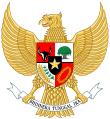
Back Constitución de Indonesia Spanish قانون اساسی اندونزی FA Constitution de l'Indonésie French Undang-Undang Dasar Negara Republik Indonesia Tahun 1945 ID Angger-Angger Baku Indonésia JV ინდონეზიის კონსტიტუცია KA Undang-Undang Dhâsar Naghâra Rèpublik Inḍonèsia Taon 1945 MAD Undang-Undang Dasar Negara Republik Indonesia Taun 1945 MAP-BMS Undang-Undang Dasar Negara Republik Indonesia Tahun 1945 Malay Indonesische Grondwet Dutch
| 1945 State Constitution of the Republic of Indonesia | |
|---|---|
 A 1946 print edition of the constitution, published by Indonesian National Committee Probolinggo branch | |
| Overview | |
| Original title | Undang-Undang Dasar Negara Republik Indonesia Tahun 1945 |
| Jurisdiction | |
| Created | 1 June–18 August 1945 |
| Presented | 18 August 1945 |
| Ratified | 18 August 1945 |
| Date effective | 18 August 1945 |
| System | Unitary Republic |
| Government structure | |
| Branches | 3 |
| Head of state | President |
| Chambers | People's Consultative Assembly, consisting of House of Representatives and Regional Representative Council |
| Executive | Cabinet led by the President |
| Judiciary | Supreme Court, Constitutional Court, and Judicial Commission |
| Federalism | Unitary |
| Electoral college | No |
| Entrenchments | 2 |
| History | |
| First legislature | 29 August 1945 |
| First executive | 18 August 1945 |
| First court | 18 August 1945 |
| Amendments | 4 |
| Last amended | 11 August 2002 |
| Location | National Archives of Indonesia, Jakarta |
| Commissioned by | Preparatory Committee for Indonesian Independence |
| Author(s) | Investigating Committee for Preparatory Work for Independence |
| Media type | Printed text document |
| Full text | |
| This article is part of a series on the |
| Politics of Indonesia |
|---|
 |
The 1945 State Constitution of the Republic of Indonesia (Indonesian: Undang-Undang Dasar Negara Republik Indonesia Tahun 1945, commonly abbreviated as UUD 1945 or UUD '45) is the supreme law and basis for all laws of Indonesia.
The constitution was written in June–August 1945, in the final months of the Japanese occupation of the Dutch East Indies at the end of World War II. It was abrogated by the Federal Constitution of 1949 and the Provisional Constitution of 1950, but restored by President Sukarno's 1959 Decree.
The 1945 Constitution sets forth the Pancasila, the five nationalist principles, as the embodiment of basic principles of an independent Indonesian state. It provides for a limited separation of executive, legislative, and judicial powers. The governmental system has been described as "presidential with parliamentary characteristics."[1] Following major upheavals in 1998 and the resignation of President Suharto, several political reforms were set in motion, via amendments to the Constitution, which resulted in changes to all branches of government as well as additional human rights provisions.
- ^ King (2007)